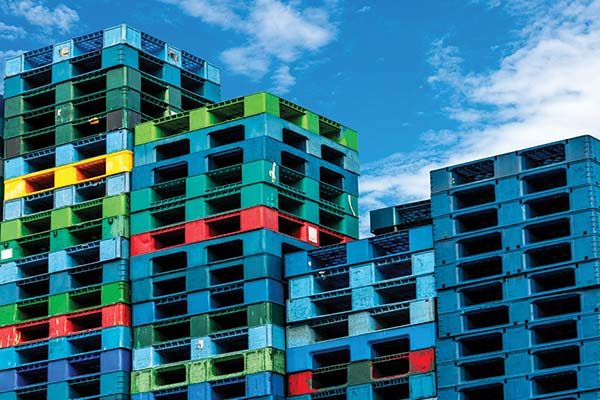Reduce and reuse your way to a greener supply chain
Demand is on the rise for reusable transport packaging solutions as companies seek to hit environmental sustainability goals.

Business leaders are looking at all aspects of their operations to find ways to become more environmentally friendly these days, from energy and water usage in their facilities, to fuel consumption in their transportation networks, to the types of paper and packaging they consume across their operations. Experts say packaging is an especially hot topic, and they point to the growing ranks of businesses seeking sustainable solutions for product transport—the boxes, trays, pallets, and containers used to move products through their supply chains.
Demand for reusable transport packaging (RTP), as it’s known, increased 66% in 2020 and was expected to rise 88% in 2021 on its way to even higher levels this year, according to the Reusable Packaging Association (RPA), which published its first annual “State of the Industry” report on RTP in late 2020 and plans to release new data later this year. Consumers’ concern for the environment and the growing use of automated equipment throughout the supply chain were driving forces cited at the time, and they continue to be key motivators, according to Norm Kukuk, president of reusable packaging manufacturer Orbis and a member of RPA, which represents both suppliers and users of reusable packaging.
“We are seeing more interest, absolutely,” says Kukuk, emphasizing the increased demand for reusables in the food, medical, and pharmaceutical industries, which have also been major adopters of automated material handling equipment. “Our plastic packaging is high tolerance [so it can be used more easily] on conveyors and in automation. Because of that, [plastic] pallets and handheld totes are seeing more demand.”
But plastic isn’t the only reusable getting attention. Metal and wood factor into it as well, according to RPA, which defines reusable transport packaging solutions as those made from durable materials designed for multiple uses in rigorous operations and logistics systems. They stand in contrast to “one-way” packaging solutions, such as corrugated boxes and containers, which are designed for a single use before being recycled or tossed in a landfill. Reusable transport packaging represented a little more than 20% of the total global packaging market in 2020, also according to RPA, a figure that is rising as business customers and consumers alike seek to become part of the circular economy.
“These packaging products are designed for lasting use in a system that ensures their effective recovery and return for continuous purpose,” according to RPA. “Reusable transport packaging products are largely designed for business-to-business applications, although the growth of e-commerce and home delivery applications is opening opportunities for the effective use of reusable packaging for transporting merchandise to households” as well.
MAKING A ROUND TRIP
The goal of reusable transport packaging is to replace one-way solutions with those that can be used multiple times. Pallets are a case in point. Both wood and plastic pallets can be reused, and increasingly, the plastic variety are being used over and over again in food and beverage operations, often because they are easy to clean and are less prone to contamination, according to Kukuk. Third-party logistics service providers (3PLs) are investing more in this type of reusable packaging as well, he says.
“Our goal is to replace limited-use with high-volume-reuse packaging,” says Kukuk, adding that Orbis’ plastic pallets, in particular, are designed for the circular economy—where they’re used as many times as possible. It’s all part of a broader effort to develop a “circular supply chain,” in which the reusables are returned to the point of origin to be refilled and sent out again. In other models, reusables are managed by a third party that pools pallets, containers, and other reusables and then readies them for reuse by other partners in the pooling system.
The frequency of reuse varies. Pallet lifespan, for instance, largely depends on how the unit is used, and manufacturers of both the plastic and wood varieties tout the virtues of whichever type they make. Kukuk says one of Orbis’ plastic pallets recently underwent testing at the Virginia Tech Center for Packaging and Unit Load Design and was found to have a lifespan of more than 400 cycles, for instance. Meanwhile, experts at the National Wooden Pallet & Container Association note that wood is the only 100% renewable and recyclable reusable product available, and that wooden pallets still dominate the market. But no matter where a company stands on the issue, both products fit the bill as reusable transport packaging and can become part of a company’s environmental sustainability story—especially as environmental, social, and governance (ESG) initiatives gain prominence in supply chains.
“Our customers have ESG [objectives] that they are committed to, [and] we are helping them understand how reusable packaging can help them meet those goals,” Kukuk explains, noting that Orbis recently hired a sustainability director to advance those efforts.
A separate industry study on the demand for returnable transport packaging underscores those sentiments. A March 2023 report from the market research firm Future Market Insights estimated that the returnable transport packaging market would hit nearly $28 billion this year and rise to nearly $46 billion over the next 10 years, primarily due to an increased focus on reuse and recycling worldwide, ongoing demands to reduce waste, and a push to reduce the utilization of single-use packages in favor of the round-trip variety. The report cites the retail, food and beverage, logistics, chemicals, and building and construction sectors as key market drivers.
A CASE IN POINT
A recent sustainable packaging project by the materials science company W.L. Gore & Associates illustrates the ways in which companies are trying to reduce their environmental impact by rethinking the way they transport goods. Gore—which is best known for its waterproof, breathable Gore-Tex fabrics—switched from using single-use cardboard containers to transport large, bulky rolls of one of its products to using reusable metal racks. Ken Staz, the company’s U.S. regional logistics operations leader, presented details of the project at the recent annual meeting of the Warehousing Education and Research Council (WERC), a warehouse industry trade group.
Staz explained that the previous shipping method required customers to either discard or recycle the cardboard boxes once the product was received—taking the disposal decision out of Gore’s hands. To gain more control over the process, Gore built a prototype of a reusable metal shipping rack that could accommodate the 240-pound rolls of product. Once the product has been removed, the racks can be broken down at the customer location and shipped back for re-use. Today, Gore is using the racks for international shipments, which are handled by the company’s third-party logistics service provider. The 3PL manages the labeling and tracking of the racks for shipping as well as sorting, inspecting, and restocking the racks at Gore’s facilities after they’ve been returned.
Staz told attendees the project will achieve a return on investment (ROI) in just over three years and has yielded annual cost savings as well.
Above all, he says, it reinforces the company’s desire to be kinder to the environment and demonstrates its willingness to take on projects aimed at meeting that goal.
“Today, sustainability is more front of mind than it has been historically,” he told attendees.
Related Articles

Copyright ©2024. All Rights ReservedDesign, CMS, Hosting & Web Development :: ePublishing